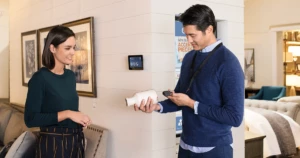
Improving benefit access with Alluma
Twenty years ago, the state of California was staring down an impending crisis. Due to cost, access, and complexity, roughly two million children across the state were living without health insurance.[1] While California offered its own Children’s Health Insurance Program (CHIP), the program’s complex requirements—including a 28-page application that took over an hour and a half to complete—kept hundreds of thousands of working families from leveraging the safety net they needed.
Enter Alluma. The organization’s founders recognized the demand for more accessible care solutions, and in 2001 released a streamlined online CHIP application with the ability to sign electronically—reducing the application time from 97 minutes to seven. Suddenly, California’s most vulnerable populations had an accessible resource that advocated on their behalf and helped connect them to the vital services the state provides.
In the years since, Alluma has worked alongside state and local government agencies to help ensure at-risk populations don’t slip through the cracks. Whether through more accessible applications, improved online tools, or innovative authentication processes, Alluma’s efforts have made access to benefits far more accessible for those who need them.
Recently, I was able to sit down with Alluma’s Executive Director of Communications, Shineh Rhee, and Kristan Drzewiecki, Executive Director of Business Development to learn more about how the organization is using its human-centered methods to better serve people during the COVID-19 pandemic.
What were the industry challenges that made you form Alluma? Tell us more about your mission.
Shineh Rhee: Alluma came out of a collaboration between a few different organizations, leaders who were trying to figure out why people weren’t able to connect to the services that they needed. In particular, they were looking at the rates of enrollment in California’s Children’s Health Insurance Program, or CHIP, and why they were so low. As they investigated that problem, they realized that it was because the lengthy paper application was such a barrier for folks. So Alluma created the first web-based enrollment application with an electronic signature for a public benefit program in the country. We were able to reduce the time it took to fill out the CHIP application from 97 minutes to 7 minutes.
The CHIP application project turned into what we now call One-e-App (OeA). OeA was our initial web-based application that was used by a variety of California counties and then became the basis for our platform with Health-e-Arizona Plus, the state’s integrated eligibility system.
Kristan Drzewiecki: And it wasn’t just about the technology, we actually had to push to change the state and federal policy beyond the ability to accept a witnessed ink signature. The ability to make it possible to apply electronically was dependent upon this policy change to enable it to be allowed as opposed to the paper and ink signature. A big part of our DNA is about policy driving technology, and policy and technology working hand in hand, looking at how addressing policy barriers opens up technology to serve as a tool.
KD: Another example of this interplay is when a number of our leaders and former leaders were invited by Senator Barbara Mikulski from Maryland to help write the technology section of the Affordable Care Act. The work that they contributed to Section 1561 evolved into the operational guidance called The Seven Standards and Conditions, which is what the Centers for Medicare and Medicaid Services use as a checklist to determine whether or not solutions qualify for federal funding. Their work in understanding what’s needed to meet the goals of the Affordable Care Act because of our history as one of the first in web-based electronic application and eligibility determination resulted in this invitation to contribute on a national level.
State, county, and local government agencies, community-based organizations, and managed care systems have used your solutions to connect people to multiple benefits, from Medicaid and SNAP to EITC to locally-based programs using modular and end-to-end integrated eligibility and enrollment solutions. Tell us more.
SR: We try to approach the problems holistically rather than providing a one-size-fits-all solution. Our focus has always been getting people connected, and keeping them connected, making sure that our client partners have the tools they need to ensure that people aren’t facing too many hurdles in the front end as they try to get in and that they’re not getting disenrolled for different reasons, particularly technological barriers. Now, we are launching our newest solution, One-X-Connection, which has evolved with the times based on everything we’ve learned in the past 20 years in partnership with our clients. One-X-Connection uses modern technology to reflect the fact that agencies need a more modular and flexible solution.
KD: We take a multi-path approach to integration that combines policy, technology, design, and data. Those are the four components of how we look at potential clients’ challenges. We’re really starting with our why, and our why is about connecting people to services.
KD: When we say design, we’re talking about human-centered design and that is based on years of doing fieldwork, shadowing helpers who are helping people apply for benefits, observing people who are applying for benefits, doing interviews and focus groups, and really understanding how people interact with the technology. That focus on people is built into our solutions, in all our language that’s written at a sixth grade or lower readability level, the flow of the screens, the colors that are chosen, the amount of white space on the page — there are reasons for everything.
SR: On the flip side of the technology solutions are our consulting services. We really dig deep with our clients and partners to understand what that landscape looks like and what the problem looks like. We worked with the California Department of Social Services as they explored modernizing their verification processes and structure. They were really a leader and like-minded partner in recognizing that it’s not just about the technology, it’s about all of the different elements and diverse constituency of this massive program, and how you make that successful in the long term. It took a lot of stakeholder research and really understanding the policies involved, and then helping them understand how to go on that pathway of technology modernization within what they currently do in their landscape.
What makes the needs during a crisis more challenging? Can you share some examples of solutions you’ve created that can specifically help people connect to benefits during a crisis like COVID-19? Tell us about your approach and the lessons you’ve learned.
SR: This crisis is unprecedented and really alarming. Seeing how many millions of people are wrestling with the barriers in the system right now reaffirmed our mission, this is what we were made to do — to help make that process and that system better. You’ve probably heard about how outdated some of these systems are, how hard they are to navigate, and how, unfortunately, they don’t speak to each other. We’re working on the back end with agencies and partnering with the many leaders trying to streamline and connect these processes.
Our newly launched Quick Screener for California is our rapid response on the front end, using our understanding of how people really live and are going to react while going through an application process. There will be millions of people who have never had to apply for benefits before trying to figure out how it works now. It’s really difficult. You have to go to so many different sites and only some of them are updated. It’s not the fault of the organizations, it’s just that things are constantly changing and it’s hard to coordinate across different places and have them talk to each other. Even just trying to find eligibility information can be confusing and disorienting. You often hit dead ends.
We knew we could make that experience easier for people. If you can help people understand that they might be eligible, it’s going to encourage them to take that next step. It can be a little daunting when you look at the application and see how much information it requires or how long it is. Especially when you’re not sure if you’re even going to qualify and there’s some stigma still attached to it in this country. Those are some of the principles that went into developing our Quick Screener — making it as fast and easy as possible, making sure it’s anonymous so that people feel comfortable, making the language really and simple to navigate, and making people feel empowered. We’re excited about sharing this Quick Screener publicly for free because we think that it can have a role in helping people who are facing some of the toughest times of their lives feel a little more secure and in control in this time of confusion and anxiety.
What have you done with the tool and how has it been received so far?
SR: We’ve just recently launched the tool after a beta phase. We wanted to make sure that we understand what organizations and partners on the ground are going through because a lot of them are overwhelmed. Our human-centered focus means figuring out what tools we need to give our partners to make it easier for them to share. So far, the feedback we’ve heard has been great. People feel like it’s really useful and they think the anonymity is really important for their populations. We’ve also released the Spanish version and will be conducting wider public outreach. We’re hoping to do some sort of analysis and report after a couple of months.
We’ve also built out the results page. It’s very short. It takes less than three minutes to answer the basic questions that you need, then you’ll get to the results page which will show your likely eligibility and directs you to the exact application that you need based on your zip code so that you don’t have to search for it — which we know from research is an issue. We’ll send you to the right source application and include a bunch of other resources to better curate the masses of information that is out there in terms of other resources, services for undocumented populations, etc.
If other states are interested, how can they do something similar?
KD: We want to hear from them and hear what their challenges are. If others are experiencing many of the same challenges that we observed in California, we would love to speak with them to see if customizing the Quick Screener for their program is the right solution, or if there are other ways we can use our policy, technology, design, and data toolkit to help them identify different ways to address this unprecedented surge in people seeking help.
SR: We’ve been thinking about this a lot. Obviously, we want to react quickly, and we want to get something out there which is why we have been fighting to improve this system for our entire organization’s existence. This crisis is uncovering some of the things that were broken, things that people have known could be better for a long time, and now a lot of states and counties are reflecting on their systems in order to build a more connected ones for the long term that really puts people at the center.
There’s no doubt that Rhee, Drzewiecki, and the rest of the Alluma team are working diligently to help bring peace of mind to those at risk in today’s environment. To learn more about Alluma visit alluma.org, or click here to learn how Microsoft is responding to COVID-19, together.
[1] https://lao.ca.gov/1999/0699_low_income_health_coverage.html




